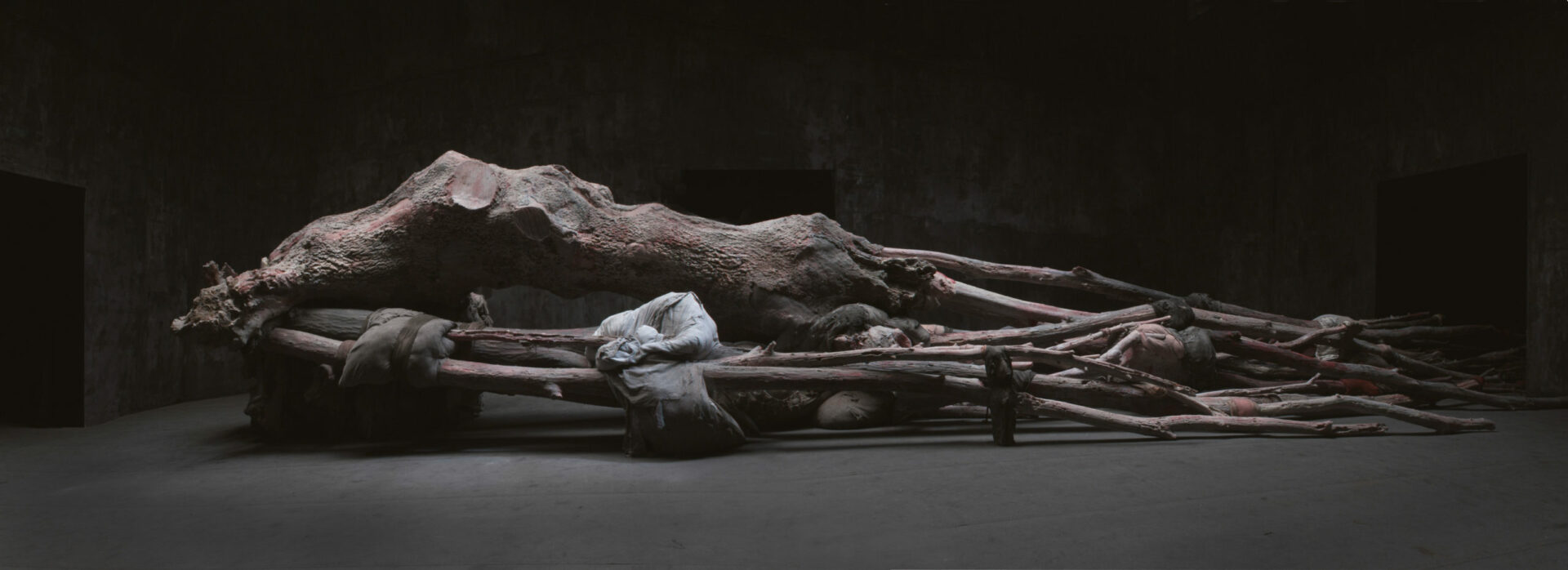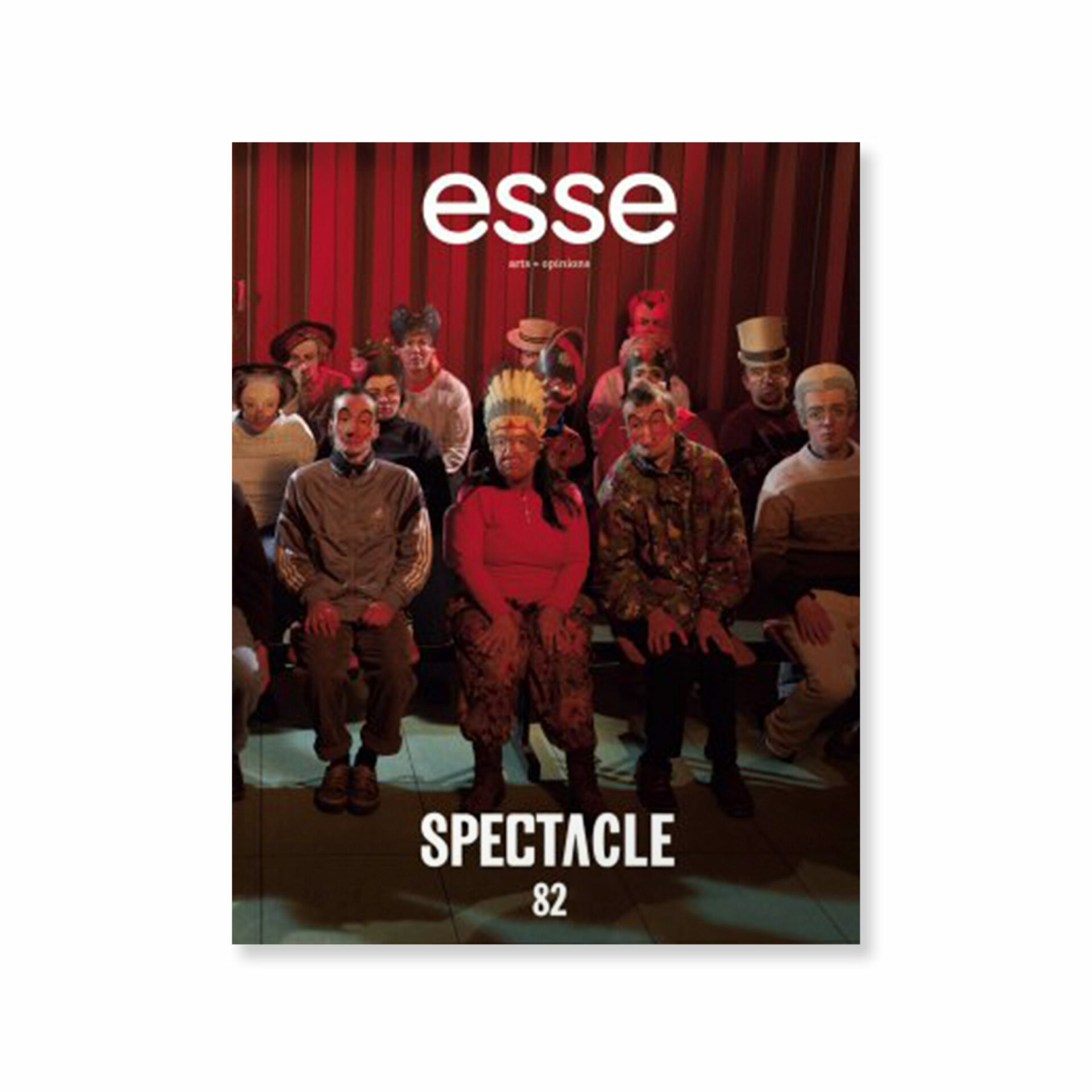The Flayed Tree : Rethinking The Ethics of Care And Responsibility In Berlinde de Bruyckere’s Cripplewood

Photo : © mirjam devriendt, courtesy of the artist
Neither dead nor alive, Flemish artist Berlinde De Bruyckere’s Cripplewood (2012–13), an enormous uprooted elm, lies defeated in the Belgian Pavilion at the 55th Venice Biennale. A welcome interlude from Venice’s chaotic brightness, the experience of entering the tenebrous and meditative pavilion, an austere building of elegant purity, is comparable to the experience of entering a mausoleum. The quiet darkness of the space and the lingering smell of melted wax demand silent contemplation and respect. Bandaged by large swatches of rough black cloth, the walls have been covered with layers of paint and plaster. Soft Venetian light barely penetrates the sombre space through a large skylight that has been veiled by dark tattered fabric, creating an otherworldly glow.
Cripplewood is sprawled across the pavilion’s central nave. De Bruyckere’s sculpture, which commands the viewer’s attention through its scale and materiality, sculpts how we navigate the space, thereby inscribing temporality in the viewing experience. Unsettlingly fragile, the tree’s knotted limbs entangle and reach horizontally like arms, reminding us of the delicate nature of human bones. Monumental and threatening, the suffering trunk’s tenacious vitality illuminates the darkened space, exuding the vulnerability and triumph of life in the face of death. The large tree is cast in wax, an unstable and perishable material. The tree’s wax bark has been peeled off, revealing tender delicate skin and exposing wounds that have become scars. Evoking the pulsating physicality of a lived body, the tree’s pink marbled skin has been painted in a palette that may remind us of the vitalism and luminous transparency of human flesh. Soft cushions support the tree’s exposed and damaged body. Inspired by red fabrics depicted in the paintings of Venetian masters, De Bruyckere has carefully bandaged the tree’s wounded limbs with deep red cloths that seem soaked in blood. The gnarled, wounded martyr seems to be calling for our care.
Due to its uncanny mimetic abilities, wax has often been employed in medical, artistic, and religious contexts to preserve images of ephemeral human bodies. Indeed, the organic material’s capacity to render permanent what is fleeting has been praised by artists and scientists for centuries.1 1 - Georges Didi-Huberman, “Viscosities and Survivals: Art History Put to the Test by Materials,” in Roberta Panzanelli, ed., Ephemeral Bodies: Wax, Sculpture and the Human Figure (Los Angeles: Getty Research Institute, 2008), 154–69. The compliant material is malleable and can easily be sculpted by hand, poured into moulds, or used to cast a body or a tree, reproducing the subtle lines on a face or the texture of a tree’s bark with astonishing precision. Like memories inscribed in Aristotle’s wax tablet,2 2 - In De Anima (III, 429b29) Aristotle suggests that memories are imprinted on the mind through perception, like carvings on a wax tablet. De Bruyckere’s wax moulds preserve the movements and expressions of live bodies. De Bruyckere creates several plaster casts of various models that are later filled with layers of pigmented wax. Mending the wounds with melted wax, De Bruyckere’s works are formed as the material cools and solidifies. While her wax shells might seem to be the antithesis of classical bronze sculptures, De Bruyckere’s process of re-membering fragmented body parts brings to mind the work of Auguste Rodin, who often assembled his sculptures from fragmented body casts that were lying around in his studio. By attending to the insistent instability of De Bruyckere’s work, viewers become aware of the vital materiality of wax. The inherently transformative material can be temporally materialized in transitory physical states, thereby evoking processes of birth, metamorphosis, dissolution, and regeneration. De Bruyckere invites her viewers to be attentive to Cripplewood’s material transformation. As we enter the pavilion, we feel as though we are disturbing the tree’s never-ending metamorphoses. Unlike Franz Kafka’s Gregor Samsa, who becomes a “monstrous verminous bug” overnight, Cripplewood is not a crystallized hybrid but a becoming body of flesh and bark.
While she was not regularly exposed to works of art as a child, De Bruyckere recalls being moved by reproductions of Lucas Cranach the Elder’s paintings.3 3 - Berlinde De Bruyckere, interview by Hans Theys, “On doubt and openess, Lucas Cranach the Elder and the colours red and green. Hans Theys in discussion with Berlinde De Bruyckere,” in Cornelia Wieg, ed., Into One-Another. Berlinde De Bruyckere in Dialogue with Cranach and Pasolini (Munich: Hirmer Verlag, 2011), 26. Indeed, the influence of Cranach’s manner of expressing the internal pain and suffering of his subjects through the physical body is visible in De Bruyckere’s wax works. Transformed by the warmth of the moulded and moulding forms, wax retains the emotions of lived bodies as they are expressed physically. Rather than acting as a barrier between self and other, viewing subject and cast subject, the viscous consistency and tactile qualities of wax enable us to emotionally connect with De Bruyckere’s subjects. While Descartes’s play with wax persuaded him to doubt his sense perceptions and speculate that the mind and the body are two distinct substances,4 4 - René Descartes, Meditations on First Philosophy, trans. Michael Moriarty (Oxford: Oxford University Press, 2008), 17–24. De Bruyckere’s use of wax, the material best capable of imitating both the external and internal flesh, frames an inter-subjective encounter between cast subject and viewing subject. Through the encounter between the viewer’s human flesh and the sculpture’s waxy flesh, De Bruyckere’s work blurs the boundaries between self and other while simultaneously denying the viewer access to the cast tree’s private, traumatic wounds.
De Bruyckere seems to recognize the unsettling nature of empathic engagement, which gives rise to messy entanglings of self and other. While the capacity to empathize with another’s suffering is contingent upon one’s own experience of pain, it is through a recognition of the other’s experience as other that ethical empathic encounters are possible. Despite the material and poetic similarities that compel me to identify with De Bruyckere’s Cripplewood, the enormous elm’s size and monumentality force me to recognize that Cripplewood is also very much unlike me.
In “Violence, Mourning, Politics,” Judith Butler suggests that grief and mourning are political resources that can potentially inspire us to be attentive to the precariousness of life. According to Butler, we encounter the vulnerability and precariousness of other bodies and of our own bodies through our encounters with other bodies. She writes, “The body implies mortality, vulnerability, agency: the skin and the flesh expose us to the gaze of others, but also to touch, and to violence, and bodies put us at risk of becoming the agency and instrument of these as well.”5 5 - Judith Butler, Precarious Life: The Powers and Mournings of Violence (New York: Verso, 2004), 26. The collective experience of grief forms communities by revealing the fundamental interdependency of all beings and challenging the notion of the self as autonomous. Butler states that loss makes a “tenuous ‘we’ of all of us.”6 6 - Ibid. Indeed, it is through the mourning of Cripplewood that the interdependency between Self and Other, human and non-human, is disclosed.
De Bruyckere’s site-specific installation invites us to reconsider our ethical engagement with, and responsibility toward, the natural world. By disclosing the vitality of non-human matter, De Bruyckere’s fallen tree invites us to contemplate how we address, and are addressed by, the other humans and non-humans with whom we share a world. De Bruyckere’s flayed tree urges us to be attentive to the interdependency between Self and Other, and the vulnerability and precariousness of life as it is revealed in times of mourning.




